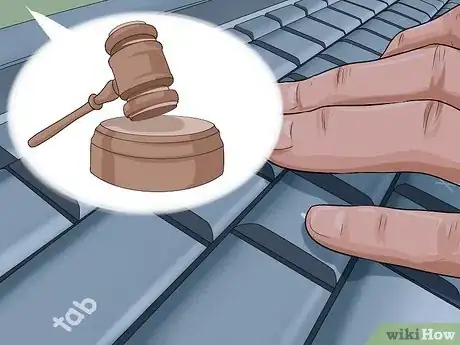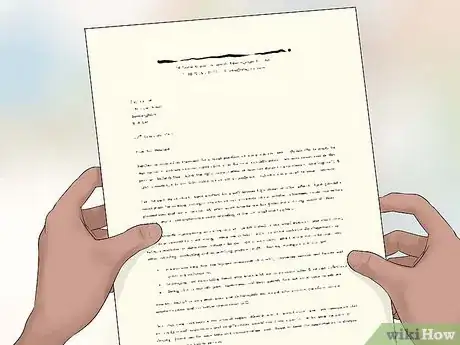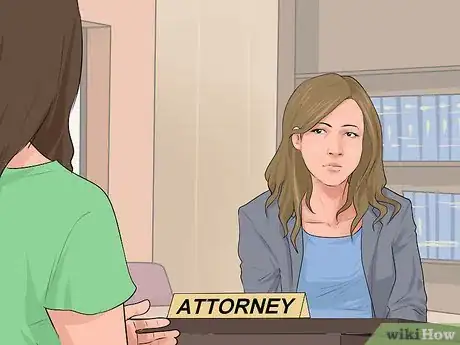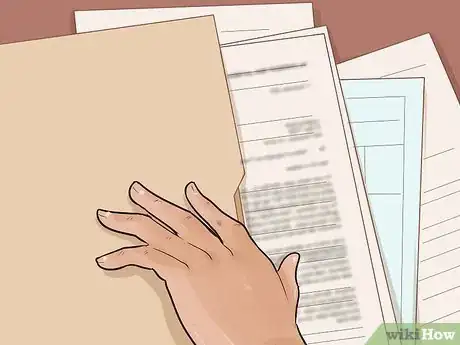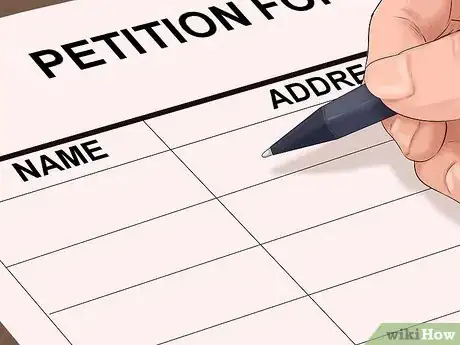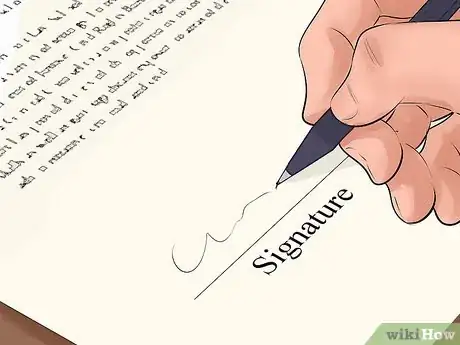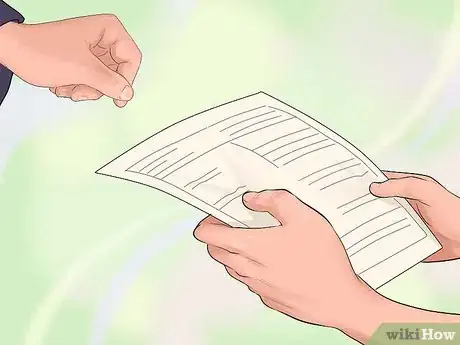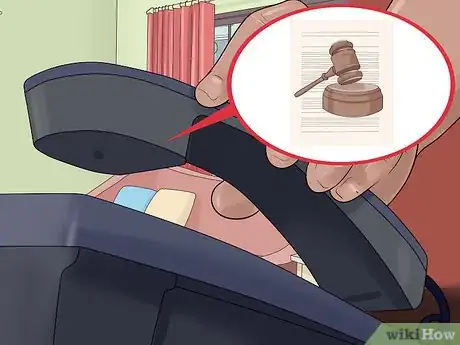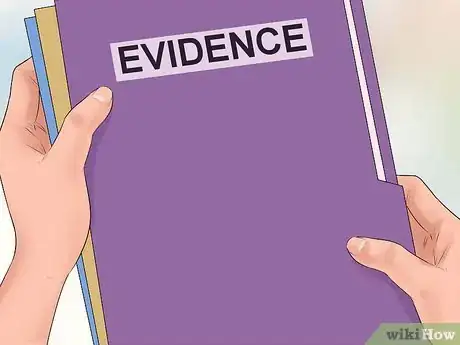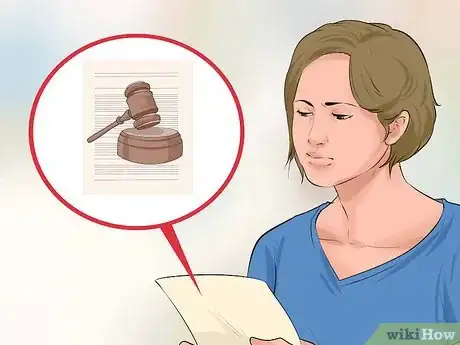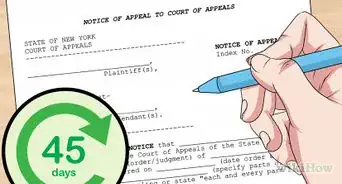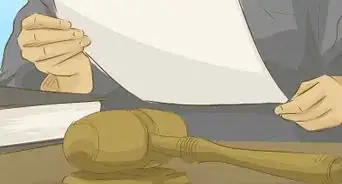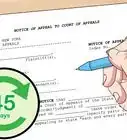This article was written by Jennifer Mueller, JD. Jennifer Mueller is an in-house legal expert at wikiHow. Jennifer reviews, fact-checks, and evaluates wikiHow's legal content to ensure thoroughness and accuracy. She received her JD from Indiana University Maurer School of Law in 2006.
This article has been viewed 57,883 times.
Small claims courts in Texas provide a forum for you to have a justice of the peace decide your case using simplified rules in a less formal setting than formal courts. If you have a claim for money damages only totaling $10,000 or less, you can file a small claims lawsuit in Texas. Any individual over the age of 18 can use the small claims courts in the state, as well as some businesses as long as they aren't suing to collect a debt.
Steps
Preparing Your Case
-
1Research Texas law. Your dispute can't be resolved by a justice of the peace unless there's a state law that provides you a legal remedy.
- If you're familiar with TV shows such as "The People's Court," you have a good idea of the types of cases commonly heard in small claims court. For example, if you lent a few hundred dollars to a friend and she refused to pay you back, you could sue her in small claims court.[1]
-
2Check the statute of limitations. The justice of the peace has no power to decide your case unless it's filed within the time period set by state law.
- For most cases, the deadline is two years from the date the event occurred that gave rise to the dispute. However, other claims have a statute of limitations as long as four years. Generally, you don't want to wait any longer than six months to a year before you file your lawsuit.[2]
Advertisement -
3Choose the right court. Typically you would sue in the justice court of the county where the defendant lives.
- You also can sue in the county where the events happened that gave rise to your claim. As a result, sometimes you have several courts to choose from that have appropriate jurisdiction. In those situations you can pick whichever one is most convenient for you.
- If there's more than one justice court in the county, you must use the one covering the area where the defendant lives, or the location where the dispute happened.[3]
- If you're unsure about which court to use, you can call the justice of the peace's office. If you provide the address of the person or business you want to sue, they typically will let you know where you need to file your claim.[4]
- Keep in mind that justice courts can only hear claims for money damages of less than $10,000. If your claim is worth more than that, you can't agree to recover less just so you can have it heard in justice court.[5]
-
4Send a demand letter. Before you file your lawsuit, give the other party an opportunity to settle the dispute without going to court.
- In your letter, you should briefly explain the law that entitles you to damages, and provide details of the amount you are owed. For example, suppose someone opened his car door and hit your car, which was parked next to his. The scratch and dent on your car cost you $350 to repair. You also had to clock out of work two hours early to take your car to a shop and get it fixed. Your demand would include the cost of repair and two hours of lost wages.
- If you have a dispute with a business, you also might be able to have your dispute resolved by filing a complaint with the Better Business Bureau or a local trade association.[6]
- Stick to the facts, and avoid getting emotional or insulting the person. Simply explain what happened and why you believe that person or business is responsible for whatever harm has come to you. Ask for specific compensation and provide a deadline to respond. Let them know that you are prepared to file a lawsuit in small claims court if they don't meet your demand by that date.[7]
-
5Consider consulting an attorney. Even if you can't afford an attorney to represent you, you may be able to find an attorney willing to give you a free consultation and discuss the merits of your case.
- Texas does allow attorneys to appear in small claims court. If you're suing for a significant amount, or you feel uncomfortable speaking in front of a judge, you might consider hiring an attorney to represent you.[8]
- In many cases, you're entitled to recover your attorney's fees if you win your case. Additionally, some attorneys may be willing to represent you on a contingency fee basis, meaning the attorney will only be paid if she wins your case.[9]
- If you have low income and worry you may not be able to afford an attorney, you may be eligible for free or reduced-fee legal services from your local legal aid office or a law school clinic. You can find out about these services by calling the State Bar of Texas referral service at 1-877-9TEXBAR or visiting the website at www.texasbar.com.[10]
-
6Gather information. Since some counties require you to fill out your petition form in person at the clerk's office, you should get together all the necessary information you'll need before you head to the courthouse.
- For example, Dallas County requires you to appear in person at the clerk's office to fill out your form. Pulling together all the documents and information you need ahead of time will keep you from making multiple trips back and forth retrieving information.
- To complete the claim form, you'll need your complete name and address, the complete name and address of the people or businesses you're suing, the amount of your claim, the basis of your claim, and any amount you owe the person you're suing.
- You must determine the full legal name of the person or business you're suing before you go to the clerk's office. If you're suing a business, this means you must look up the business's legal name. If you're suing a corporation, you also must include the name of the registered agent for service. You can get this information by calling the Secretary of State's office at 1-800-252-1386.
- If you are suing a partnership or a sole proprietor, you must name both the people and the business name in your lawsuit. You can find out this information by contacting the county clerk's office in the county where the business is located.[11]
- Some counties such as Bexar County have small claims petition forms available online.[12] If you have this option, you should look at the form before you start gathering information so you have a better sense of the information you'll need.
- To compute your damages, you must determine how much money it would take to put you back into the same position you were before the wrong was committed.[13] For example, if you took your car to a mechanic for repairs, and later determined that the mechanic charged you for repairs that weren't made, getting the money back for the repairs that weren't made would put you in the same position you were before he overcharged you. The repairs still haven't been made, but you haven't paid for them either.
- Because procedures vary among courts, it may be valuable for you to call the clerk's office and make sure you have all the information you need and are prepared to fill out your petition.[14]
Filing Your Lawsuit
-
1Fill out your petition form. Once you've gathered all the information you need, you're ready to fill out the required form to file your small claims lawsuit.
- Take all the records you have that are relevant to your claim, including copies of contracts or receipts, with you to the courthouse when you fill out your petition.[15]
- You will have to write out a brief statement of your claim. You might consider writing this statement before you go to the courthouse, so you have time to edit your statement and make sure you've included all the important facts. Then when you arrive to fill out your form, all you have to do is copy it down.[16]
- You also must complete a civil case information sheet. This form provides a basic summary of your lawsuit and includes the names and contact information of all the parties to the suit.[17]
-
2Sign your petition. When you sign your petition, you must swear under oath that all the information you've provided is correct to the best of your knowledge.
- Generally, you must sign your petition in front of the clerk so the clerk can verify your signature.[18]
-
3File your petition. You must give your petition to the clerk for the justice court that you want to hear your case to initiate your small claims lawsuit.
- When you file your petition, you will have to pay a filing fee. The filing fees vary among counties, but generally are under a hundred dollars. For example, Dallas County charges filing fees of $31. In addition to that filing fee, you must pay a service fee of $75 for each defendant you're suing. Bexar County charges $46 to file your petition plus a service fee of $80 for each defendant.[19]
- If you can't afford filing fees, you can request an application from the clerk to have the fees waived. You must have this application notarized when you sign it, and submit it at the same time you file your lawsuit. The judge will review the financial information you provide on the application and determine whether you're eligible for a fee waiver.[20]
- When you file your petition, ask the clerk how the court sets trial dates, since procedures may vary among courts. The clerk will let you know if any further action is needed from you before the trial date is set.[21]
-
4Have the defendant served. Before the justice of the peace can hear your case, you must be able to verify that the defendant had legal notice of the lawsuit against him.
- If you file a petition in small claims, the clerk will take care of service for you after you've paid the service fees or been granted a fee waiver. However, it is your job to follow up with the clerk's office and find out if service has been completed. The clerk won't contact you to notify you of the status.[22]
-
5Wait for an answer. Once the defendant is served, he has 14 days to respond to your petition.
- You should call the clerk's office two weeks after you file your petition and find out if the defendant has been served. If he has, get the exact date of service from the clerk and use that date to calculate the defendant's deadline to file an answer to your lawsuit.[23]
- The date the defendant was served also is used in most courts to calculate the trial date. If the defendant has been served when you call, ask the clerk if a trial date has been set.[24]
- You should also find out your case number from the clerk, if you don't already have it. Write it down and keep it in a safe place, because you will need it to follow up on your case or file any additional documents.[25]
Attending Your Trial
-
1Prepare for trial. If the defendant responds and indicates he is contesting your claim, you must get ready to argue your case before the justice of the peace.
- Use the statement you wrote for your petition to frame your case. Compare it to the documents or other items you have that you want to bring to the court for evidence. For example, if you are suing a dry cleaner for ruining your shirt, you want to bring the shirt with you as evidence.[26]
- If you have any witnesses, you can call them to testify at your hearing. Talk to your witnesses and find out if they are willing to come to court and testify on your behalf. You also can have the clerk issue subpoenas for your witnesses ordering them to appear on your trial date, for an additional fee.[27] This subpoena fee may include a cash amount for the witness. Subpoena fees typically are the same as service fees, with the additional cash tender for the witness.[28]
- Since you filed the petition, you must prove all the facts that establish your claim, as well as the amount of your damages. If you haven't already, gather the documentation that helps prove your case at trial.[29]
- Typical evidence in a small claims case includes copies of any contracts or agreements, receipts or cancelled checks, and photographs. Make sure you have at least two copies of any documents you want to introduce as evidence at trial – one for the judge and one for the defendant.[30]
- While you're preparing your case, you should also decide – if you haven't already – whether you want to have a trial by jury. You can make this decision at any time after you've filed your lawsuit, but you must make your request at the clerk's office at least 14 days before your trial date. You'll have to pay an additional fee if you want a jury trial.[31]
-
2Participate in mediation. Some counties may give you the option of mediating your dispute.
- If your county makes this option available, you may be asked when you file your petition or even on the day of trial if you would prefer to use mediation. You won't be charged any additional fees for using mediation, and if you're unable to reach an agreement you still may have your case heard by a judge.[32]
-
3Appear on your trial date. If you're unable to resolve your claim before the date your trial is scheduled, you must appear in court on that date or your case will be dismissed.
- Try to arrive at the courthouse at least 30 minutes before the time your case is scheduled so you have time to go through security, find your courtroom, and take a seat. At the beginning of each court session, the judge may have a docket call where she goes through all the cases she will hear during that session to verify the parties are present and ready to go.[33]
- When the judge calls your case, she typically will give you a brief explanation of court procedures and how she will handles things in her courtroom. Then she'll give you an opportunity to ask any questions and confirm you understand what she's explained.[34]
- If you appear in court and the person you sued isn't there, you may win your case by default. You must show that the defendant had proper notice of the lawsuit and prove the specific amount of damages you're owed, but you don't have to prove anything else.[35]
-
4Present your case. Since you filed the petition, you will have the opportunity to speak first. The judge will swear you in and then you can proceed with a brief opening statement.
- If you have any witnesses, you can call them up to the witness stand and ask them questions. The other side also will have the opportunity to question them based on the questions you asked.[36]
- After you've made your case and submitted all of your evidence, the defendant will have the opportunity to tell the judge his side of the story. Just as you did, he also may present evidence or call witnesses. If the defense calls witnesses, you also have the opportunity to ask them questions.[37]
-
5Receive the judge's decision. Once both sides have presented their cases, the justice of the peace makes her judgment and issues her order. She may do this immediately after the conclusion of your case, or she may take some time to review the evidence presented and then issue her order.[38]
- If you are unhappy with the judge's decision, you have 14 days from the date the order is issued to file a motion for a new trial, or 21 days to file an appeal.[39]
- If you won your case, you may have to take steps with the court to enforce the judgment and collect the money the defendant owes you.[40]
References
- ↑ https://www.texasbar.com/AM/Template.cfm?Section=Consumer_and_Tenant_Rights1&Template=/CM/ContentDisplay.cfm&ContentID=24859
- ↑ https://www.texasbar.com/AM/Template.cfm?Section=Consumer_and_Tenant_Rights1&Template=/CM/ContentDisplay.cfm&ContentID=24859
- ↑ https://www.texasbar.com/AM/Template.cfm?Section=Consumer_and_Tenant_Rights1&Template=/CM/ContentDisplay.cfm&ContentID=24859
- ↑ https://www.texasbar.com/AM/Template.cfm?Section=Consumer_and_Tenant_Rights1&Template=/CM/ContentDisplay.cfm&ContentID=24859
- ↑ https://www.texasbar.com/AM/Template.cfm?Section=Consumer_and_Tenant_Rights1&Template=/CM/ContentDisplay.cfm&ContentID=24859
- ↑ https://www.texasbar.com/AM/Template.cfm?Section=Consumer_and_Tenant_Rights1&Template=/CM/ContentDisplay.cfm&ContentID=24859
- ↑ https://www.texasbar.com/AM/Template.cfm?Section=Consumer_and_Tenant_Rights1&Template=/CM/ContentDisplay.cfm&ContentID=24859
- ↑ https://www.texasbar.com/AM/Template.cfm?Section=Consumer_and_Tenant_Rights1&Template=/CM/ContentDisplay.cfm&ContentID=24859
- ↑ https://www.texasbar.com/AM/Template.cfm?Section=Consumer_and_Tenant_Rights1&Template=/CM/ContentDisplay.cfm&ContentID=24859
- ↑ https://www.texasbar.com/AM/Template.cfm?Section=Consumer_and_Tenant_Rights1&Template=/CM/ContentDisplay.cfm&ContentID=24859
- ↑ https://www.texasbar.com/AM/Template.cfm?Section=Consumer_and_Tenant_Rights1&Template=/CM/ContentDisplay.cfm&ContentID=24859
- ↑ http://home.bexar.org/jp/smallclaims.html
- ↑ https://www.texasbar.com/AM/Template.cfm?Section=Consumer_and_Tenant_Rights1&Template=/CM/ContentDisplay.cfm&ContentID=24859
- ↑ https://www.texasbar.com/AM/Template.cfm?Section=Consumer_and_Tenant_Rights1&Template=/CM/ContentDisplay.cfm&ContentID=24859
- ↑ https://www.texasbar.com/AM/Template.cfm?Section=Consumer_and_Tenant_Rights1&Template=/CM/ContentDisplay.cfm&ContentID=24859
- ↑ https://www.texasbar.com/AM/Template.cfm?Section=Consumer_and_Tenant_Rights1&Template=/CM/ContentDisplay.cfm&ContentID=24859
- ↑ https://www.texasbar.com/AM/Template.cfm?Section=Consumer_and_Tenant_Rights1&Template=/CM/ContentDisplay.cfm&ContentID=24859
- ↑ https://www.texasbar.com/AM/Template.cfm?Section=Consumer_and_Tenant_Rights1&Template=/CM/ContentDisplay.cfm&ContentID=24859
- ↑ http://home.bexar.org/jp/filing_fees.html
- ↑ https://www.texasbar.com/AM/Template.cfm?Section=Consumer_and_Tenant_Rights1&Template=/CM/ContentDisplay.cfm&ContentID=24859
- ↑ https://www.texasbar.com/AM/Template.cfm?Section=Consumer_and_Tenant_Rights1&Template=/CM/ContentDisplay.cfm&ContentID=24859
- ↑ https://www.texasbar.com/AM/Template.cfm?Section=Consumer_and_Tenant_Rights1&Template=/CM/ContentDisplay.cfm&ContentID=24859
- ↑ https://www.texasbar.com/AM/Template.cfm?Section=Consumer_and_Tenant_Rights1&Template=/CM/ContentDisplay.cfm&ContentID=24859
- ↑ https://www.texasbar.com/AM/Template.cfm?Section=Consumer_and_Tenant_Rights1&Template=/CM/ContentDisplay.cfm&ContentID=24859
- ↑ https://www.texasbar.com/AM/Template.cfm?Section=Consumer_and_Tenant_Rights1&Template=/CM/ContentDisplay.cfm&ContentID=24859
- ↑ https://www.texasbar.com/AM/Template.cfm?Section=Consumer_and_Tenant_Rights1&Template=/CM/ContentDisplay.cfm&ContentID=24859
- ↑ https://www.texasbar.com/AM/Template.cfm?Section=Consumer_and_Tenant_Rights1&Template=/CM/ContentDisplay.cfm&ContentID=24859
- ↑ http://home.bexar.org/jp/filing_fees.html
- ↑ https://www.texasbar.com/AM/Template.cfm?Section=Consumer_and_Tenant_Rights1&Template=/CM/ContentDisplay.cfm&ContentID=24859
- ↑ https://www.texasbar.com/AM/Template.cfm?Section=Consumer_and_Tenant_Rights1&Template=/CM/ContentDisplay.cfm&ContentID=24859
- ↑ https://www.texasbar.com/AM/Template.cfm?Section=Consumer_and_Tenant_Rights1&Template=/CM/ContentDisplay.cfm&ContentID=24859
- ↑ https://www.texasbar.com/AM/Template.cfm?Section=Consumer_and_Tenant_Rights1&Template=/CM/ContentDisplay.cfm&ContentID=24859
- ↑ https://www.texasbar.com/AM/Template.cfm?Section=Consumer_and_Tenant_Rights1&Template=/CM/ContentDisplay.cfm&ContentID=24859
- ↑ https://www.texasbar.com/AM/Template.cfm?Section=Consumer_and_Tenant_Rights1&Template=/CM/ContentDisplay.cfm&ContentID=24859
- ↑ https://www.texasbar.com/AM/Template.cfm?Section=Consumer_and_Tenant_Rights1&Template=/CM/ContentDisplay.cfm&ContentID=24859
- ↑ https://www.texasbar.com/AM/Template.cfm?Section=Consumer_and_Tenant_Rights1&Template=/CM/ContentDisplay.cfm&ContentID=24859
- ↑ https://www.texasbar.com/AM/Template.cfm?Section=Consumer_and_Tenant_Rights1&Template=/CM/ContentDisplay.cfm&ContentID=24859
- ↑ https://www.texasbar.com/AM/Template.cfm?Section=Consumer_and_Tenant_Rights1&Template=/CM/ContentDisplay.cfm&ContentID=24859
- ↑ https://www.texasbar.com/AM/Template.cfm?Section=Consumer_and_Tenant_Rights1&Template=/CM/ContentDisplay.cfm&ContentID=24859
- ↑ https://www.texasbar.com/AM/Template.cfm?Section=Consumer_and_Tenant_Rights1&Template=/CM/ContentDisplay.cfm&ContentID=24859
About This Article
If you’re claiming money damages of 10,000 dollars or less in Texas, you can file a small claims lawsuit. Before you file your petition, check the statute of limitations to make sure you’re within the claim period, which is usually 2 years after the event. You’ll also need to send a demand letter for the cost of damages before you go to a small claims court. This way, the defendant has an opportunity to pay what they owe. You can choose to sue in the county where the event happened or where the defendant lives. You’ll need to file a petition form with the court, pay the processing fee, and serve the defendant notice of the trial. The fees vary between counties, but expect to pay at least 100 dollars. Some counties will also give you the opportunity for mediation before you go to trial. Although you don't need an attorney, it might help your case to have a professional represent you. For more tips from our Legal co-author, including how to present your case in court, read on!


